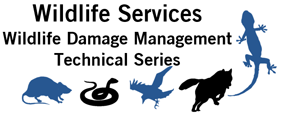United States Department of Agriculture: Animal and Plant Health Inspection Service

Wildlife Damage Management Technical Series
Date of this Version
10-2016
Document Type
Article
Citation
Avery, M.L. and A.G. Duffiney. 2016. Cedar Waxwings. Wild-life Damage Management Technical Series. USDA, APHIS, WS National Wildlife Research Center. Ft. Collins, Colorado. 8p.
Abstract
Prevention and control of cedar waxwing (Bombycilla cedrorum) damage to small fruits such as blueberry, cherry, and strawberry is vexing to growers in many parts of the United States. Cedar waxwings (Figure 1) travel in flocks and descend in large numbers on berry crops, especially during winter and migration. In short feeding bouts, waxwings eat, peck, or knock substantial amounts of fruit from the plants. These frugivores are difficult to discourage once they become established at a given location. Harassment early and often using pyrotechnics or other sudden noisemakers can help prevent flocks from being established. The most effective preventative measure is exclusion using an appropriate netting system. Visual and auditory deterrents have limited effectiveness as flocks rapidly habituate. Chemical repellents based on methyl anthranilate as the active ingredient are readily available. Permits for lethal control can be difficult to obtain.
Included in
Behavior and Ethology Commons, Biodiversity Commons, Other Animal Sciences Commons, Other Ecology and Evolutionary Biology Commons, Population Biology Commons, Terrestrial and Aquatic Ecology Commons

